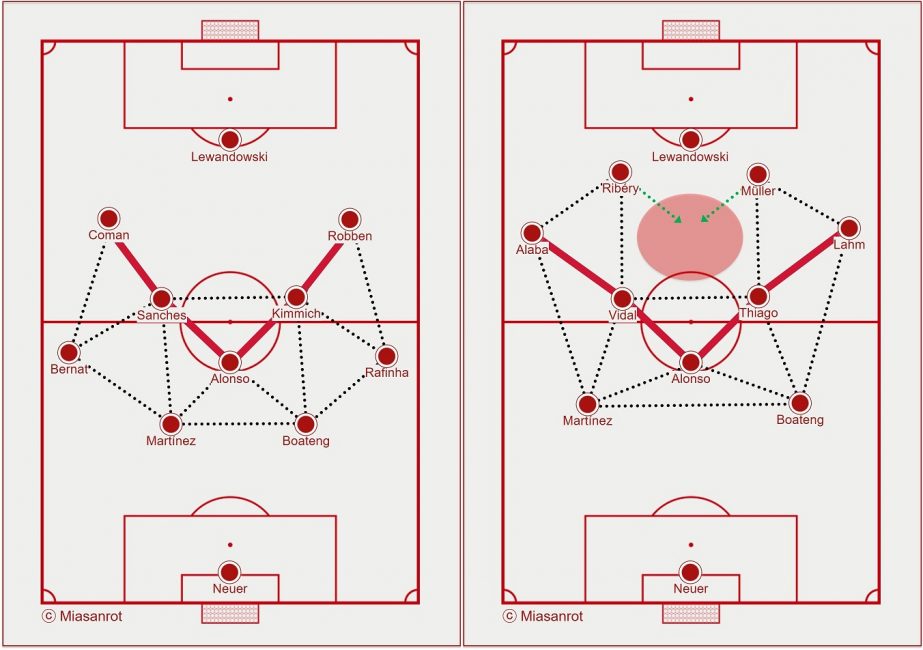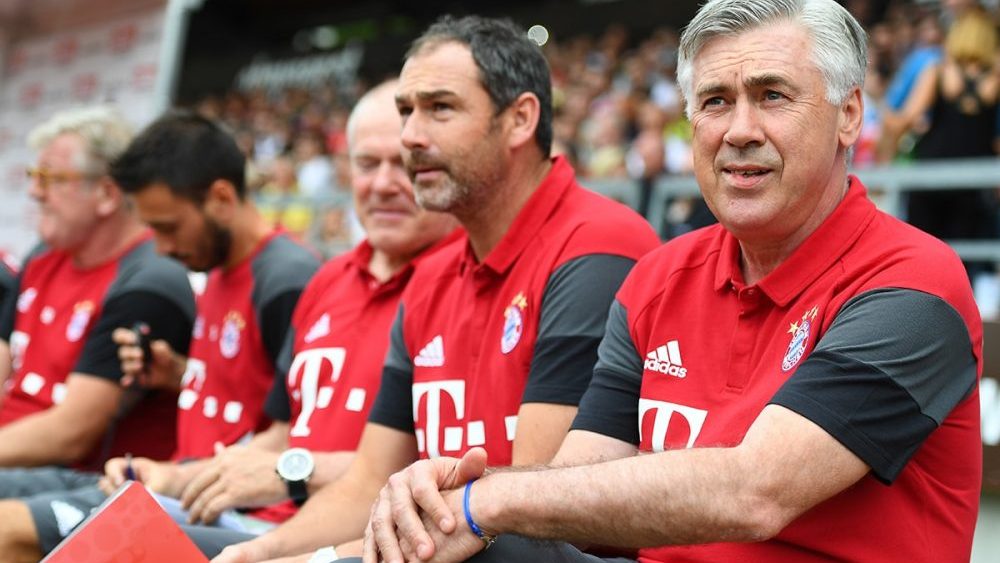State of Ancelotti
In the last few days it’s seemed like Carlo Ancelotti has managed in 100 days to do what Pep Guardiola needed three years for. Out of the partly-glowing songs of praise before and at the start of the season, after a defeat to Atlético and a draw with Cologne, criticism, both quiet and loud, about the playing style of Bayern under the new coach started to grow and grow.
Ancelotti, who knows best the sometimes remarkable pirouettes of the media coverage from Madrid, Milan and London, won’t let that throw him so quickly. Among other things, the fact that Franck Ribéry recently made an appeal to the whole team, demanding more cooperation on the pitch, shows, however, that there’s an element of uncertainty among the players about their own condition too.
After around six weeks after the first competitive game under Ancelotti, it’s worth taking a look into the details. What’s FC Bayern’s situation under the new manager?
The bare numbers
Says enough that we really need to look for parameters where Bayern is not #1. There are a few where they’re #2. pic.twitter.com/r7pdyFWxc0
— 11tegen11 (@11tegen11) 5. Oktober 2016
FC Bayern are leading the table with a three-point advantage over Hertha BSC. Much more importantly, the record champions have currently got a four-point lead over Dortmund and are ahead of Leverkusen and Gladbach by six points.
In the Bundesliga, Bayern has by far the most shots per game (19) and within the area (13.3) according to whoscored.com, meaning they’re also doing better in that aspect than last season (18; 11.7). Under Ancelotti, Bayern have somewhat less possession (65.8% vs 66.4%) and a slightly weaker pass completion rate (87.2% vs 88%). They’re allowing one shot fewer than last season too, which is impressive when you consider how strong they were at the back last season (6.7 vs 7.5). FC Bayern are dribbling less (21 vs 27) and are putting in more crosses than in Guardiola’s last year (19 vs 16). Robert Lewandowski leads the team in shots with 5.2 per 90 minutes to one decimal place, just like last season.
So far so good. The fact that Bayern, with 4/6 games at home and opponents like Bremen, Hamburg or Ingolstadt, have had one of the easiest opening programmes of the Bundesliga, should not be ignored in this context. If one could see in Ancelotti’s first games that Bayern were attempting a more direct game in attack, this trend sort of died down after the very chaotic game against Schalke. At the same time, the counter-pressing has become more and more aggressive than at the start.
The Ancelotti V

The most conspicuous change in comparison to the previous years concerns the most conspicuous characteristic of the Guardiola era. The positional play. Ancelotti has simplified the structures in attack enormously. The Ancelotti V has become the defining characteristic. The V, which begins with Alonso or whoever is playing in defensive midfield, is relatively simple, but makes a number of triangles possible. The wingers can drift inside, and the full-backs make up the V, or extend it by dropping back. When Müller plays, the V is at least now and then a little wonkier, when the German international vacates the flanks and often leaves Lahm to occupy the right side alone. When Rafinha plays, whoever is playing on the right-wing holds their position stronger, like against Cologne, while the Brazilian operates further back. So the 10-zone in this structure is purely for Lewandowski, the wingers or a midfielder bombing forwards. Barely any passes are made in this area.
Big presence by Robben, in the limited time he featured.#Bayern‘s spacing is very constant this season.#passmap pic.twitter.com/HGcCB2VtIb
— 11tegen11 (@11tegen11) 1. Oktober 2016
The Ancelotti V potentially provokes a series of direct battles on the flanks, and makes the “two-man game” of winger and supporting full-back possible, which was always practised under Heynckes and Van Gaal. Above all, the role of the full-backs is again much more straight-forward than before in Guardiola’s complex conceptualisation. Alaba is involved in 3.9 shots under Ancelotti. In the previous year it was just over 2 when he played as a left-back. Lahm and Bernat are involved in more shots than last year and Ribéry has already had more shot involvements in five games (7) than in 13 appearances last season (5).
Notably, this structure worked nicely against deep-sitting opponents above all (Werder, Hertha, first half against Cologne), while it didn’t work quite so well against higher-pressing teams like Ingolstadt and most of all Atlético. Against the Spaniards what became clear early on was what captain Philip Lahm had put like this during the week: “Also our passing game isn’t how it was. Our passing game itself hasn’t changed obviously, but the positions on the pitch have. And that needs to click 100%.” Atlético’s running-intensive, aggressive game meant that Bayern’s room to make decisions was much smaller. It was visible how in some situations Bayern’s players had to look for the right position, and during this time they lost the ball while going forwards at times.
Lots of passes by Bayern, but I miss the links between Alcántara & Vidal and the links between the front three.#passmap pic.twitter.com/lqrd3bPEgh
— 11tegen11 (@11tegen11) 28. September 2016
Above all, the nominal central midfielders shifting laterally onto the V-line can sometimes take time. The fact that Bayern’s game seems faster and more direct with somewhat more-risk-friendly Thiago in defensive midfield fits the mould there. It’s only a small step from the V to the dreaded U-shape build-up, which lacks penetration.
The big question is how far FC Bayern can go with this structure. Under Guardiola, the positional play was more than a framework. It was a substantial element of their game which could often make the difference alone. The strongest moments with the previous manager in the battles with Dortmund, the 7-1 against Roma, the victories against Man City or the return leg against Atlético were very closely linked with almost perfect positional play, which on top of that was tweaked to suit the opponent.
Under Ancelotti, the V-structure and some other recurrent themes are more like a basic framework which is meant to enable the individuals to display their individual strengths. So individual class is again stronger in the foreground than collective dominance. FC Bayern’s performances are stronger again with an addition of individuality. Against 90% of the coming opponents, that will definitely pay off, but in the Atlético game showed a few limits for the time being at least.
In the previous season, Guardiola’s Bayern had dominated the switching and shifting machine from Madrid over three of four halves, and created as many high-percentage shots in the box as hardly a single other team with so much possession. The positional play was the key here too. In the 0-1 defeat last week, FCB dominated possession once more, but did not dominate the game. To blame this on mechanisms that haven’t yet been rehearsed perfectly and the relatively short practice time, as Lahm did, falls a little short. The structures we can see so far aren’t actually that complicated.
The games against Leipzig, Leverkusen and Gladbach, who can at least in terms of set-up play like Atlético, will give us more precise information here.
A forecast
It’ll be exciting to see how Bayern’s game develops further in the next months. Will it stay in the basic structure in the Ancelotti V? Will other variants be added? Will the Italian try other formations like a 3-1-4-2, which could improve build-up play, liberate Müller from his wing role, and enable the return of the “Line-up of death” with five instead of three attacking players? Considering Bayern’s stronger tendency towards individual superiority, that would only be logical.
Anyway, it’s important that Ancelotti implements his ideas. If he would like to play more directly, because he wants to get the ball into dangerous areas more quickly, he should do that. If he would also like to operate with his side lurking further back ready to strike, like with Real Madrid in Munich at the time, he should do that. Ancelotti must and should find his own way. Nothing would be worse than an FC Bayern which has Guardiola’s ideas in their head, but not the necessary tools (which were implemented in the meticulously-detailed work in training) to hand.
The situation six weeks after the first competitive game under Carlo Ancelotti is okay. The results are perhaps somewhat better than one would expect, looking at how they’ve played. There’s justifiable doubt as to whether the structures affected so far are enough to be sustainably successful as a possession team against the higher 10% of the Bundesliga and Champions League. Either way, Ancelotti should not allow himself to become entirely dependent on the individual qualities of his players.




 October 7, 2016
October 7, 2016 


